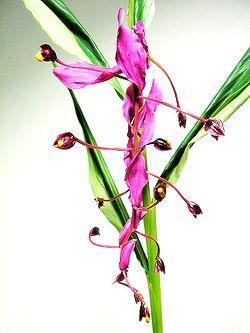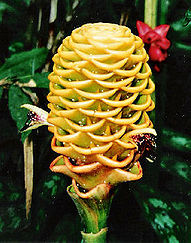
Zingiberaceae
Encyclopedia


Perennial plant
A perennial plant or simply perennial is a plant that lives for more than two years. The term is often used to differentiate a plant from shorter lived annuals and biennials. The term is sometimes misused by commercial gardeners or horticulturalists to describe only herbaceous perennials...
herb
Herb
Except in botanical usage, an herb is "any plant with leaves, seeds, or flowers used for flavoring, food, medicine, or perfume" or "a part of such a plant as used in cooking"...
s with creeping horizontal or tuberous rhizome
Rhizome
In botany and dendrology, a rhizome is a characteristically horizontal stem of a plant that is usually found underground, often sending out roots and shoots from its nodes...
s, comprising ca. 52 genera and more than 1300 species
Species
In biology, a species is one of the basic units of biological classification and a taxonomic rank. A species is often defined as a group of organisms capable of interbreeding and producing fertile offspring. While in many cases this definition is adequate, more precise or differing measures are...
, distributed throughout tropical Africa, Asia, and the Americas.
Many species are important ornamental plants, spice
Spice
A spice is a dried seed, fruit, root, bark, or vegetative substance used in nutritionally insignificant quantities as a food additive for flavor, color, or as a preservative that kills harmful bacteria or prevents their growth. It may be used to flavour a dish or to hide other flavours...
s, or medicinal plants. Ornamental genera include the shell gingers (Alpinia
Alpinia
Alpinia is a genus of plants, with more than 230 species from the Ginger family . It is named for Prospero Alpini, a 17th-century Italian botanist who specialized in exotic plants.-Description:...
), Siam or summer tulip (Curcuma alismatifolia), Globba, ginger lily (Hedychium
Hedychium
Hedychium is a genus of perennial plants native to tropical Asia and the Himalayas, commonly growing to between 120 and 180 cm tall. Common names include garland flower, ginger lily, and kahili ginger...
), Kaempferia
Kaempferia
Kaempferia is a genus of over 100 species in the plant family Zingiberaceae....
, torch-ginger Nicolaia, Renealmia
Renealmia
Renealmia is a plant genus in the family Zingiberaceae. Species include:* Renealmia alpinia* Renealmia aurantifera* Renealmia cernua* Renealmia dolichocalyx* Renealmia oligotricha* Renealmia sessilifolia...
, and ginger (Zingiber
Zingiber
The genus Zingiber contains the true gingers, a set of plants with medicinal and culinary value in many parts of the world. The most well-known is Z. officinale, garden ginger.-Culinary:...
). Spices include ginger
Ginger
Ginger is the rhizome of the plant Zingiber officinale, consumed as a delicacy, medicine, or spice. It lends its name to its genus and family . Other notable members of this plant family are turmeric, cardamom, and galangal....
(Zingiber
Zingiber
The genus Zingiber contains the true gingers, a set of plants with medicinal and culinary value in many parts of the world. The most well-known is Z. officinale, garden ginger.-Culinary:...
), galangal
Galangal
Galangal is a rhizome of plants of the genus Alpinia or Kaempferia in the ginger family Zingiberaceae, with culinary and medicinal uses originated from Indonesia...
or Thai ginger (Alpinia galanga
Alpinia galanga
Alpinia galanga, a plant in the ginger family, is an herb used in cooking, especially in Indonesian cuisine and Thai cuisine. It is one of four plants known as galangal, and is differentiated from the others with the common name greater galangal...
and others), melegueta pepper (Aframomum melegueta
Aframomum melegueta
Aframomum melegueta is a species in the ginger family, Zingiberaceae. This spice, commonly known as grains of paradise, melegueta pepper, alligator pepper, Guinea grains or Guinea pepper, is obtained from the ground seeds; it gives a pungent, peppery flavour...
), myoga
Myoga
Myōga or myoga ginger is an herbaceous, deciduous, perennial native to Japan and southern part of Korea that is grown for its edible flower buds and flavorful shoots. Flower buds are finely shredded and used in Japanese cuisine as a garnish for miso soup, sunomono and dishes such as roasted...
(Zingiber mioga), turmeric
Turmeric
Turmeric is a rhizomatous herbaceous perennial plant of the ginger family, Zingiberaceae. It is native to tropical South Asia and needs temperatures between 20 °C and 30 °C and a considerable amount of annual rainfall to thrive...
(Curcuma
Curcuma
Curcuma is a genus of about 80 accepted species in the plant family Zingiberaceae that contains such species as turmeric and Siam Tulip. The name comes from Arabic kurkum meaning "turmeric". Since assembly of the genus Curcuma by Linnaeus in 1753 about 130 species have been described so far...
), cardamom
Cardamom
Cardamom refers to several plants of the genera Elettaria and Amomum in the ginger family Zingiberaceae. Both genera are native to India and Bhutan; they are recognised by their small seed pod, triangular in cross-section and spindle-shaped, with a thin papery outer shell and small black seeds...
(Amomum
Amomum
Amomum is a genus of plant, including several types of Cardamom, especially Black Cardamom. Plants of this genus are remarkable for their pungency and aromatic properties....
, Elettaria
Elettaria
Elettaria is a genus of one or two species of cardamoms, native to southeastern Asia from India south to Sri Lanka and east to Malaysia and western Indonesia, where it grows in tropical rainforests.-Species:...
).
Characteristics
Members of the family are small to large herbaceous plants with distichous leaves with basal sheaths that overlap to form a pseudostem. The plants are either self-supporting or epiphyticEpiphyte
An epiphyte is a plant that grows upon another plant non-parasitically or sometimes upon some other object , derives its moisture and nutrients from the air and rain and sometimes from debris accumulating around it, and is found in the temperate zone and in the...
. Flower
Flower
A flower, sometimes known as a bloom or blossom, is the reproductive structure found in flowering plants . The biological function of a flower is to effect reproduction, usually by providing a mechanism for the union of sperm with eggs...
s are hermaphroditic
Hermaphrodite
In biology, a hermaphrodite is an organism that has reproductive organs normally associated with both male and female sexes.Many taxonomic groups of animals do not have separate sexes. In these groups, hermaphroditism is a normal condition, enabling a form of sexual reproduction in which both...
, usually strongly zygomorphic, in determinate cymose inflorescences, and subtended by conspicuous, spirally arranged bracts. The perianth is composed of two whorls, a fused tubular calyx, and a tubular corolla with one lobe larger than the other two. Flowers typically have two of their stamenoids (sterile stamen
Stamen
The stamen is the pollen producing reproductive organ of a flower...
s) fused to form a petaloid lip, and have only one fertile stamen. The ovary is inferior and topped by two nectaries, the stigma is funnel-shaped.
Some genera yield essential oil
Essential oil
An essential oil is a concentrated hydrophobic liquid containing volatile aroma compounds from plants. Essential oils are also known as volatile oils, ethereal oils or aetherolea, or simply as the "oil of" the plant from which they were extracted, such as oil of clove...
s used in the perfume industry (Alpinia
Alpinia
Alpinia is a genus of plants, with more than 230 species from the Ginger family . It is named for Prospero Alpini, a 17th-century Italian botanist who specialized in exotic plants.-Description:...
, Hedychium
Hedychium
Hedychium is a genus of perennial plants native to tropical Asia and the Himalayas, commonly growing to between 120 and 180 cm tall. Common names include garland flower, ginger lily, and kahili ginger...
).
Distribution
The Zingiberaceae have a pantropical distribution—found in the tropics of Africa, Asia and the Americas, with its greatest diversity in Southeast AsiaSoutheast Asia
Southeast Asia, South-East Asia, South East Asia or Southeastern Asia is a subregion of Asia, consisting of the countries that are geographically south of China, east of India, west of New Guinea and north of Australia. The region lies on the intersection of geological plates, with heavy seismic...
.
Taxonomy
- Subfamily Siphonochiloideae
- Tribe Siphonochileae
- Aulotandra
- Siphonochilus
- Tribe Siphonochileae
- Subfamily Tamijioideae
- Tribe Tamijieae
- Tamijia
- Tribe Tamijieae
- Subfamily Alpinioideae
- Tribe Alpinieae
- AframomumAframomumAframomum is a genus in the ginger family, Zingiberaceae, found in west and central Africa, and represented by approximately 50 species. It is larger than other genera in its family. Species are perennials and produce colorful flowers....
- Grains of Paradise - AlpiniaAlpiniaAlpinia is a genus of plants, with more than 230 species from the Ginger family . It is named for Prospero Alpini, a 17th-century Italian botanist who specialized in exotic plants.-Description:...
- Galangal - AmomumAmomumAmomum is a genus of plant, including several types of Cardamom, especially Black Cardamom. Plants of this genus are remarkable for their pungency and aromatic properties....
- Cyphostigma
- ElettariaElettariaElettaria is a genus of one or two species of cardamoms, native to southeastern Asia from India south to Sri Lanka and east to Malaysia and western Indonesia, where it grows in tropical rainforests.-Species:...
- Cardamom - Elettariopsis
- EtlingeraEtlingeraEtlingera is a genus of Indo-Pacific terrestrial and perennial herbs in the ginger family, Zingiberaceae consisting of more than 100 different species found, mostly, near the equator....
- Geocharis
- Geostachys
- Hornstedtia
- Leptosolena
- Paramomum
- Plagiostachys
- RenealmiaRenealmiaRenealmia is a plant genus in the family Zingiberaceae. Species include:* Renealmia alpinia* Renealmia aurantifera* Renealmia cernua* Renealmia dolichocalyx* Renealmia oligotricha* Renealmia sessilifolia...
- Siliquamomum (Incertae Sedis)
- Vanoverberghia
- Aframomum
- Tribe Riedelieae
- Burbidgea
- Pleuranthodium
- RiedeliaRiedelia (plant)Riedelia is a genus of plants in the Zingiberaceae family. The genus contains approximately 75 species that are distributed among New Guinea and the Maluku and Solomon Islands. Among the described species is Riedelia charontis, which was formally described in 2010....
- Siamanthus
- Tribe Alpinieae
- Subfamily Zingiberoideae
- Tribe Zingibereae
- Boesenbergia
- Camptandra
- Caulokaempferia (Incertae Sedis)
- CautleyaCautleyaCautleya is a small genus consisting of 3–4 species of high-altitude tropical and temperate exotic jungle gingers, native to cool forest areas of the eastern Himalayas. The plants produce popular tropical flowers widely used in the cut flower industry. They are deciduous and winter dormant. The...
- Cornukaempferia
- CurcumaCurcumaCurcuma is a genus of about 80 accepted species in the plant family Zingiberaceae that contains such species as turmeric and Siam Tulip. The name comes from Arabic kurkum meaning "turmeric". Since assembly of the genus Curcuma by Linnaeus in 1753 about 130 species have been described so far...
- Turmeric - Curcumorpha
- Distichochlamys
- Haniffia
- Haplochorema
- HedychiumHedychiumHedychium is a genus of perennial plants native to tropical Asia and the Himalayas, commonly growing to between 120 and 180 cm tall. Common names include garland flower, ginger lily, and kahili ginger...
- Hitchenia
- KaempferiaKaempferiaKaempferia is a genus of over 100 species in the plant family Zingiberaceae....
- Laosanthus
- Nanochilus
- Paracautleya
- Parakaempferia
- Pommereschea
- Pyrgophyllum
- Rhynchanthus
- RoscoeaRoscoeaRoscoea is a genus of perennial plants of the family Zingiberaceae . Most members of the family are tropical, whereas Roscoea species are native to mountainous regions of the Himalayas, China and its southern neighbours. Roscoea flowers superficially resemble orchids, although they are not related...
- Scaphochlamys
- SmithatrisSmithatrisSmithatris is a new genus of the ginger family . The first species of this genus, Smithatris supraneanae, was discovered in 1998 by Kress and Larsen, two researchers from Denmark, in the limestone hills of Saraburi Province, Thailand. The genus was thought to be monospecific until a second...
- Stadiochilus
- Stahlianthus
- ZingiberZingiberThe genus Zingiber contains the true gingers, a set of plants with medicinal and culinary value in many parts of the world. The most well-known is Z. officinale, garden ginger.-Culinary:...
- Ginger
- Tribe Globbeae
- Gagnepainia
- Globba
- Hemiorchis
- Tribe Zingibereae

